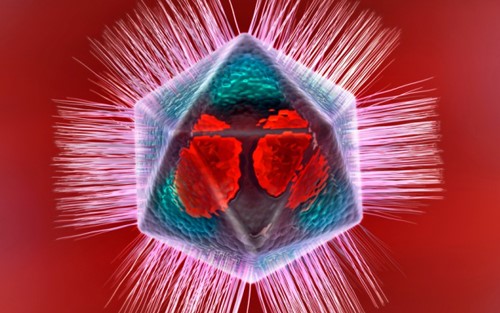February 29, a study published in "Nature" magazine, the French scientists reported that the giant virus (mimivirus) with similar systems like bacterial CRISPR defense system against foreign invasion. However, in June this year, a study published in the "Chinese Virology" (Virologica Sinica) journal Nature on this outcome but then questioned.

Nature research review: CRISPR system MIMIVIRUS like virus
MIMIVIRE is a defence system in mimivirus that confers resistanc to virophage
In fact, published in Nature this study dating back to 1992. At that time, the paper's co-corresponding author Bernard La Scola and Didier Raoult found in a cooling tower amoeba (amoebas) is one kind of great microbial infections. After years of research, scientists have finally determined in 2003, this organism is not a bacteria, but a giant virus (mimivirus).
Since then, the researchers also found that, mimivirus in fact, will be troubled by other viruses. In 2008, Raoult and La Scola found to be Mamavirus (in a Huge virus) infection of amoeba also carrying a small virus. This small object turned out to be a virus attack Mamavirus. When it appears, Mamavirus copy becomes slow, abnormal assembly and the ability of the next generation of amoeba infection becomes weaker. This team will "attack" other viruses virus named virophage.
Zamilon Virophage is the latest in a family member. 2014, Raoult and La Scola found, Zamilon only capable of infecting Mimivirus family some branches. In addition, can be infected with three branches, including a branch of Zamilon is immune. Raoult speculated that these giant viruses is the use of the CRISPR-like (CRISPR-like) of the immune system to protect themselves from Zamilon damage.
To test this conjecture, scientists analyzed 60 genomes mimivirus strains, find and Zamilon matching sequence. It was found that can withstand Zamilon infection Mimivirus have the Zamilon match DNA short chain. In addition, the researchers also found that these sequences adjacent to a gene encoding an enzyme capable of degrading DNA. This CRISPR system is very similar: CRISPR / Cas system Cas genes encoding enzymes are also nearby recognition sequence of the virus.
The study also found that blocking the CRISPR systems like the different components of the activity will mimivirus Zamilon more vulnerable to attack. Researchers will be similar to the CRISPR system named MIMIVIRE.

Virologica Sinica: Why not become MIMIVIRE adaptive immune system?
CRISPR-Cas-like system in giant viruses: why MIMIVIRE is not likely to be an adaptive immune system
June 13, published in the "Chinese Virology" (Virologica Sinica) magazine this study, France Aix - Marseille University (Aix-Marseille University) scientists of views on the Nature of the study presented challenge.
Co-corresponding author Jean-Michel Claverie and Chantal Abergel wrote in the paper: MIMIVIRE and CRISPR / Cas systems are not similar, it does not play a role by nucleic acid identification system, and is unlikely to have a real all the features of the adaptive immune system . According to The-Scientist website reported, Didier Raoult and Jean-Michel Claverie in the past to work together, but their relationship is now very popular with controversy.
In addition, this study also resistance mechanisms giant virus (mimivirus) whether the nucleic acid is entirely based question. And published in the Nature study different point of view, they believe that the giant viral resistance, the protein may interfere with the replication of virophage. Claverie and Abergel believe defense mechanisms did not look like a giant virus CRISPR.

First, the giant of the viral genome and replication virophage occurs in the same location, which is impossible to form a nucleic acid-based immune protection. Secondly, CRISPR represents short palindromic repeat (Clustered Regularly Interspaced Short Palindromic Repeats) clusters at regular intervals, and neither MIMIVIRE sequence at regular intervals, and on both sides there is no identifiable repeats. Third, the lack of a corresponding sequence before Zamilon between adjacent sequences motifs (protospacer adjacent motifs, PAMs). Bacteria usually use PAMs difference pathogen DNA and its own DNA. It is reported that target specific part of the CRISPR / Cas9 Cas9 system depends on the combination of protein and PAMs.
How do scientists think about this question
For these questions, Raoult replied: "MIMIVIRUS course not CRISPR, this is just an analogy."
The study did not question the participation of some virologists also endorsed the criticism of Claverie and Abergel. Luciano Marraffini Rockefeller University said that although on the surface, an anti-MIMIVIRE virophage (anti-virophage) system, but it seems to lack some of the iconic features CRISPR / Cas system, such as repeats, guide RNA. Rodolphe Barrangou North Carolina State University, agrees.
In addition, an anonymous commenter on the Research Forum PubPeer noted, published in Nature this study the apparent lack of RNA silencing in the control group. This eliminates the possibility that the infection may be observed virophage giant simply because the virus does not replicate.
Virologica Sinica
According to "China Virology" (Virologica Sinica) official website, the magazine was founded in 1986, published in 2007, was changed to the English language, co-sponsored by the Chinese Academy of Sciences, Wuhan Institute of Virology, Chinese Society for Microbiology, and since 2008 by the German Shi Springer Publishing House (Springer) global publication, a number of important domestic and foreign quote database and indexed.
Virologica Sinica China is biomedical core journals (bimonthly, annual 6), periodicals section contains research papers, reviews, and other types of SMS and opinions regularly to reflect the latest research progress in the field of virology and branches, covering new virus found virus pathogenesis, virus - related fields of biomedical multiple-host interactions, vaccine development, and antiviral therapy, virus-related biotechnology.
Souce: NovoPro 2016-07-12
